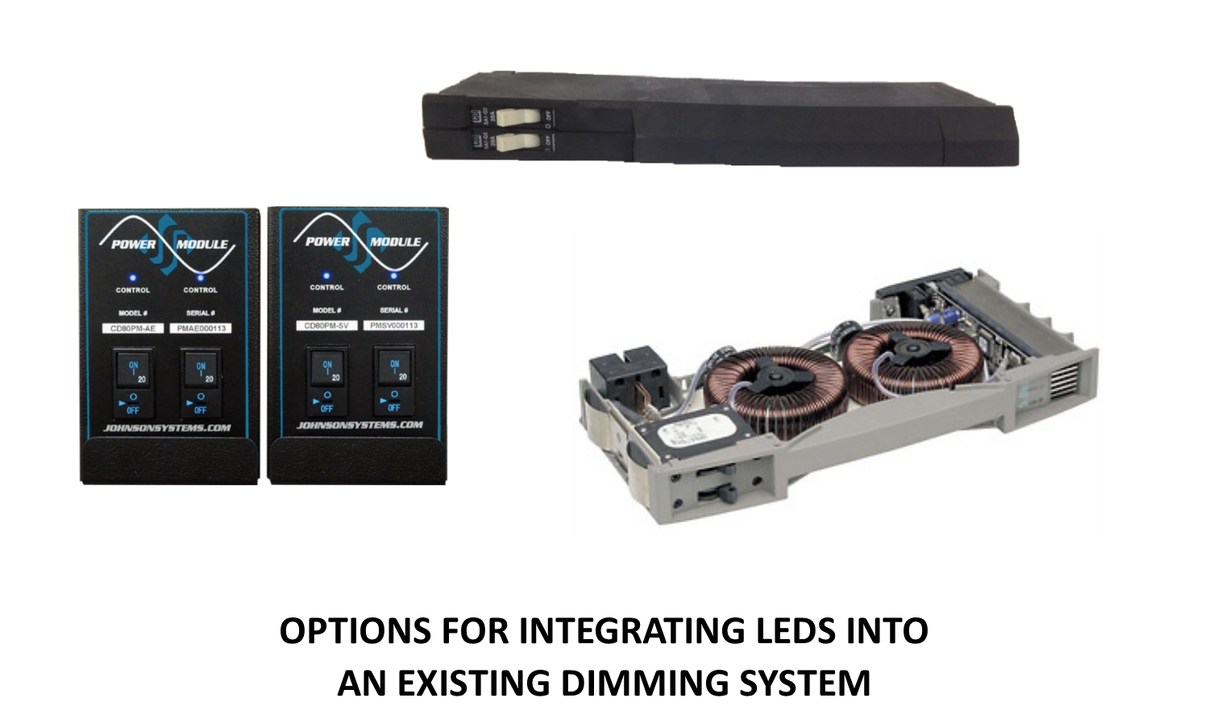Non-Dim vs. Constant Module - what's the best way to integrate LEDs without replacing my dimming system?
Many facilities are making the switch to LED and are really
happy with the results. LEDs are long-lasting, maintenance-free and
energy-saving: that's a win-win-win! However, many of our customers
have older systems where the existing dimming system is not LED compatible. The good news is that, in
most cases, we can help your system work well with LEDs. Let's
discuss:
1. Dimmers: Not
all dimmable LEDs (LED fixtures or LED "lamps") will work with
your existing dimming system! Many "dimmable" LEDs will NOT dim below a certain
percentage and will flicker the lower they go on the dimming
curve**. In addition, theatrical LED fixtures and intelligent
lights should not be used with traditional dimmers and can end up with
damage to their power supplies. So, do NOT rush out and buy dimmable
LEDs or fixtures without understanding the ins-and-outs of how LEDs and dimmers work together. We suggest doing a thorough test of one complete circuit on your
dimming system if you are changing to dimmable LEDs.
2. Non-Dims: Most existing
dimmers can be programmed to be "non-dim." What
does "non-dim" mean? Anything controlled by a
"non-dim," circuit is no longer dimmable via the rack. In traditional
dimming systems, fixtures are dimmed by a reduction of power by the
dimmer. When a dimmer is switched to a non-dim, this functionality is
lost. So a basic LED house light could turn on or off, but not be
dimmed. However, any fixture that has DMX control and is meant to be
dimmed can still be dimmed - but it is the fixture that is doing
the dimming and not a dimmer. In terms of power,
a "non-dim" unit (and the fixtures it controls) can still be
turned on-or-off through communication with the rack. When the
"non-dim" unit is off, there is no power flowing through that
unit at all. The downside to "non-dims," is that some dimming systems
may require a special handheld programmer or an old-fashioned
DOS-based computer to change a dimmer to "non-dim." If you don't
have these items on hand, you may need to hire a professional to make the switch. On other types of dimming systems, you can change the
setting to "non-dim" directly on the dimmer or the control module.
3. Constant
Modules: A "constant module" gets its name from the
fact that it always has power "constantly" running through it (and
subsequently to the fixtures that are connected to it). It cannot be
turned on or off via communication with the rack. It can only be turned
off by physically flipping the breaker on the constant module itself. Constant
modules work well with LEDs and intelligent fixtures controlled via DMX where
the dimming is done by the actual fixture. The constant module simply acts
as a pass-through to the fixtures. The downside to constant modules is that
they are always drawing and transmitting a small amount of power (which means
you are losing some of the energy-saving benefits of LEDs). Constant
modules must be purchased individually. They are specific to each dimming
system manufacturer and model and are available for most systems.
So which will work best for you? This will depend on
your ability to switch to non-dim and/or the availability and cost of constant
modules for your system. In either case, using non-dims or constants is almost
ALWAYS cheaper (and easier) than replacing your whole dimming system solely for
the sake of LEDs. As always, please feel free to talk to your technician or
call us toll-free at 866-457-5937 for more information.
**(The explanation of this phenomenon is spelled out in our
blog "Why are my LED lights flickering?" Please
check it out if you want all the technical details.)
Please note that the information above is a "basic
overview" of non-dims and constants and that there are many nuances to
these systems. Should you have questions or need additional information,
please contact us toll-free at 1-866-457-5937.

